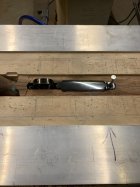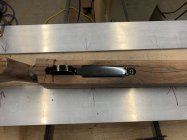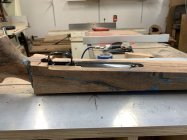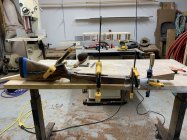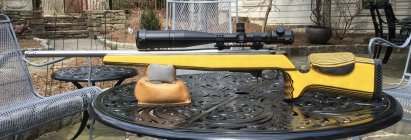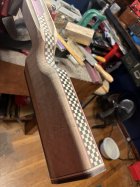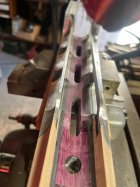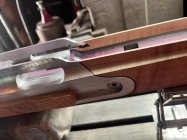You are using an out of date browser. It may not display this or other websites correctly.
You should upgrade or use an alternative browser.
You should upgrade or use an alternative browser.
Do it yourself Stock making thread
- Thread starter joshb
- Start date
joshb
Gold $$ Contributor
I finished the action cuts and partially bedded it. I slopped enough around the mag well to get an imprint of the edges so I can do an accurate cut. I can measure off my guides and get pretty close but it’s nice to have an actual line to cut to , way down there at the bottom of the cut. The bottom metal fit on these doesn’t allow for much wiggle room. I’ll drill out the center before I router the edges.

Josh, have you considered using some tee-tracks in your inletting jig to mount the guides so you don't have to nail down the stops, clamp the aluminum rails etc? Have you considered inletting a ruler/scale in there too to know how wide your guides are from center?Another 2 hours inletting. Have I mentioned that I hate inletting Model 70s?View attachment 1492559
joshb
Gold $$ Contributor
Back a few years, I thought of doing things like that. I thought of making templates for all the different actions, even different barrel contours.Josh, have you considered using some tee-tracks in your inletting jig to mount the guides so you don't have to nail down the stops, clamp the aluminum rails etc? Have you considered inletting a ruler/scale in there too to know how wide your guides are from center?
Analyzing it, I figured it would take a lot of time, effort and not really work. I use different routers and the bases are all different. Dewalt and Bosch are 6” but not perfectly centered. Porter Cable are 5 3/4” and have the same inaccuracy.
The blanks I cut have different widths. Some are 2 1/8”, 2 1/4”, some are 2 1/2” or 3”.
When I cut some barrel contours and magazines, the guide rails have to be angled.
With all those variables, I resigned myself to doing a lot of measuring for each stock.
It has an upside. I really do stocks to stay busy and active. All the adding, subtracting and figuring helps keep my brain working. Without all the templates, every one of my stocks is different. I can get a little creative with different forms and profiles, trying different ideas. I haven’t made a perfect one yet, so I keep trying.
I put in a couple hours cutting the mag well and roughing in the bottom profile of the fore end.

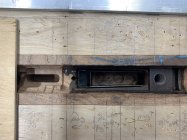

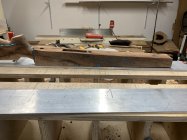
Last edited:
It obviously works for you. I've been following this thread for years now I guess. It's been fun reading it all.Back a few years, I thought of doing things like that. I thought of making templates for all the different actions, even different barrel contours.
Analyzing it, I figured it would take a lot of time, effort and not really work. I use different routers and the bases are all different. Dewalt and Bosch are 6” but not perfectly centered. Porter Cable are 5 3/4” and have the same inaccuracy.
The blanks I cut have different widths. Some are 2 1/8”, 2 1/4”, some are 2 1/2” or 3”.
When I cut some barrel contours and magazines, the guide rails have to be angled.
With all those variables, I resigned myself to doing a lot of measuring for each stock.
It has an upside. I really do stocks to stay busy and active. All the adding, subtracting and figuring helps keep my brain working. Without all the templates, every one of my stocks is different. I can get a little creative with different forms and profiles, trying different ideas. I haven’t made a perfect one yet, so I keep trying.
I put in a couple hours cutting the mag well and roughing in the bottom profile of the for
joshb
Gold $$ Contributor
I keep a hope that a younger guy might pick it up as a side line business. If he made some action and bottom metal templates, it would speed up the process and make it a viable business. A CNC machine is a major overhead expense but seems to be the new way to go. The days of handmade stocks is waning but there are still some guys keeping it alive.It obviously works for you. I've been following this thread for years now I guess. It's been fun reading it all.
It’s nice to hear that you enjoy the thread.
Thanks!
DShortt
Gold $$ Contributor
I think I liked it 'loud' as well if not better. I like unusual things and that's something I've not seen before.I made a stock a few years ago with bumblebee laminate and left the outside yellow. I was feeling it was a bit too loud, so I sanded the yellow off to the next layer of black. I’ll hit it with some black annaline dye and redo the epoxy coating.
View attachment 1496526
View attachment 1496517View attachment 1496518View attachment 1496519
joshb
Gold $$ Contributor
That’s interesting!A friend of mine Scott Davis is this Bas Ass stock. I’m posting a few pic of his work in progress.
joshb
Gold $$ Contributor
I finished shaping the Mesquite stock. Did a taper from the lug to the tip. Just pushed it thru the table saw, then sanded it smooth. I used a 15 degree router bit along the top sides and a 1/2 radius along the bottom. I used the big disc sander to angle down to the grip and the palm sander for final shaping. Now I’ll fill any cracks I exposed with an epoxy mix with turquoise dust.







joshb
Gold $$ Contributor
This one gets epoxy in the rotisserie. It’s a truck gun so I want a tough exterior.Oil finish?
No, it’s fine. It’s buried way back in the thread. I use Titebond 2 when I make a blank out of thinner boards. I’ve used it for 20+ years on cabinetry and furniture and never had a problem of failure. I read the comments posted and I have to say I’ve never left a project or stock out in the blazing Sun for hours except some garden gates and trellises I made for clients. They held up fine, thru the years.I thought about doing a test in my wifey’s oven.I apologize if I have overlooked this but what do you use for adhesive/glue?
There's another thread on the forum where fellas are really arguing the intricates of this. I'm thinking you've been at this long enough to have formed an opinion I would value.
I use colored West System epoxy for the ebony grip caps and forend tips. I wipe down the ebony with acetone to remove the oils on the surface before gluing them together.
I actually just thought of glue up I did with Titebond that was out in the blazing Sun a lot.
I glued up some gunwale caps for my boat. They’re still fine after 25 years. I can’t explain why that other guy had problems.
DShortt
Gold $$ Contributor
I suspected as much but I don't have enough experience to comment. Thanks for the benefit of your experience. Also appreciate the remarks about your prepping techniques prior to gluing. That stuff matters a lot.This one gets epoxy in the rotisserie. It’s a truck gun so I want a tough exterior.
No, it’s fine. It’s buried way back in the thread. I use Titebond 2 when I make a blank out of thinner boards. I’ve used it for 20+ years on cabinetry and furniture and never had a problem of failure. I read the comments posted and I have to say I’ve never left a project or stock out in the blazing Sun for hours except some garden gates and trellises I made for clients. They held up fine, thru the years.I thought about doing a test in my wifey’s oven.
I use colored West System epoxy for the ebony grip caps and forend tips. I wipe down the ebony with acetone to remove the oils on the surface before gluing them together.
I actually just thought of glue up I did with Titebond that was out in the blazing Sun a lot.
I glued up some gunwale caps for my boat. They’re still fine after 25 years. I can’t explain why that other guy had problems.
Similar threads
- Replies
- 2
- Views
- 558
- Replies
- 2
- Views
- 475
Upgrades & Donations
This Forum's expenses are primarily paid by member contributions. You can upgrade your Forum membership in seconds. Gold and Silver members get unlimited FREE classifieds for one year. Gold members can upload custom avatars.

Click Upgrade Membership Button ABOVE to get Gold or Silver Status.
You can also donate any amount, large or small, with the button below. Include your Forum Name in the PayPal Notes field.
To DONATE by CHECK, or make a recurring donation, CLICK HERE to learn how.

Click Upgrade Membership Button ABOVE to get Gold or Silver Status.
You can also donate any amount, large or small, with the button below. Include your Forum Name in the PayPal Notes field.
To DONATE by CHECK, or make a recurring donation, CLICK HERE to learn how.










